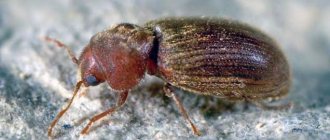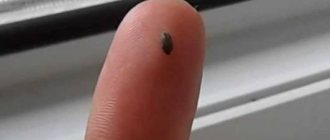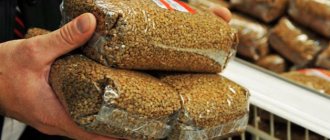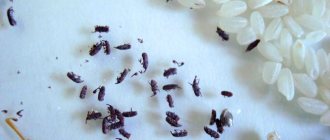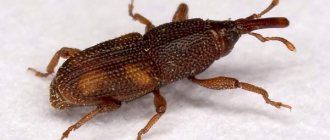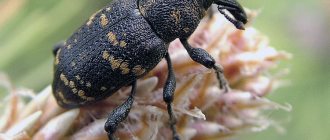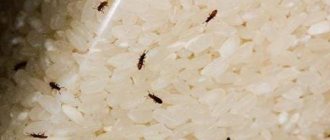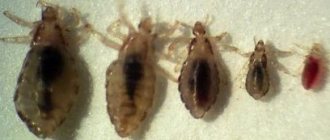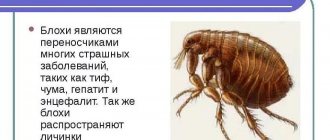Sooner or later, almost every kitchen is faced with an invasion of parasites. It is noteworthy that the appearance of worms does not at all depend on the housewife’s neatness: they can appear even in a perfectly clean kitchen.
Any kitchen can be attacked by a wide variety of parasites.
Let's figure out how these parasites threaten your kitchen, where they come from and, most importantly, how to get rid of bugs in the kitchen.
Why do bugs appear in the kitchen?
First of all, you need to understand that if you have food in your kitchen, then bugs can appear in any case, no matter how hard you try to maintain order.
Cereals receive bugs while still in the warehouse.
There may be several sources of infection:
- The most common way bugs appear in the kitchen is from the grocery store. Do not be surprised. Even a hermetically sealed bag of cereal can contain parasite larvae and adults. They can get into cereals and groceries both directly during sorting and already in the store if storage conditions are violated.
- From neighbors through ventilation. If your neighbors turn a blind eye to the problem, sooner or later strike squads of bugs will make their way to you through the ventilation. Since they reproduce very quickly, their presence will soon become noticeable.
- Some parasites can be found in textiles or wooden products. Therefore, we recommend that you wash towels or oven mitts well, and put wooden utensils in the freezer for a couple of hours.
Note! Even one spotted bug is a reason to be wary and take treatment and prevention measures. Therefore, carefully monitor the condition of your kitchen and do not neglect processing cereals after purchasing them.
In addition, many bugs love animal food, so it is better to put it in the pantry or refrigerator.
Causes of flour bugs
It's easy to get bugs. Both the owner and the manufacturer of the product can provoke their appearance. This may be a violation of GOST technologies or storage conditions and incorrect “neighborhood” in the warehouse, a violation of the tightness of the packaging, the expiration of the cereal, or ingress from the outside.
Through the fault of the housewife, infection can occur at home:
- Improper storage of cereals. Increased dampness in the house and storage in unsealed conditions create conditions for the appearance of insects. Cereals should not be stored in a warm place.
- Storage of expired products. Cereals that have been stored for a long time have a much higher chance of becoming food for pests. You should always check the expiration date and throw away bad cereals promptly.
- Incorrect packaging. When storing in bags, they should be closed, avoiding open areas. Ideal containers are glass or plastic containers with lids.
Treats from relatives and neighbors can also cause infection. Especially if you take from your hands products that are loved by pests. These are not necessarily cereals; sometimes insects can enter the house with other household items.
Some places are favorite among harmful insects. Especially because they are the hardest to find there:
- Food products and their remains in bags, unsealed containers and other containers. Especially tea leaves, seasonings, dried fruits.
- In a kitchen set, they become the sole owners of the shelves and are able to gnaw holes in them.
- Other furniture.
Risk areas include the cooking area, where waste particles are regularly left behind.
Attention! They can get into the house in a thousand ways, from barley borrowed by a neighbor to purchased furniture and equipment.
In some cases, bugs can settle in places that are “inedible” for them. Therefore, when buying products secondhand or borrowing products from someone, it is better to be vigilant. Goods purchased by weight or at fairs are also dangerous.
Types of bugs
It is important to understand that depending on the type of new kitchen inhabitants you have, methods of dealing with them may vary significantly. And sometimes they are not needed at all: for example, small (less than one millimeter) white bugs that can occasionally be seen in the kitchen are ordinary wood bugs. They feed on dust from your furniture, are non-toxic and do not harm human health.
White bugs: not a very pleasant, but harmless neighborhood.
True, there is another side to this - they can serve as food for other bugs with more unpleasant behavior. Therefore, we recommend that you read the information below and try to determine who you are up against and what products you may have to throw away.
One of the most common types of bugs in the kitchen is the red flour beetle. This is a tiny parasite, up to two millimeters in length, with small, hard wings of a bright red color. By themselves, they are quite harmless: they do not eat food and do not live long. However, they multiply quickly. Their small white larvae are almost invisible in foods: flour, rice, oatmeal. Small worms actively feed on cereals, leaving waste in them and spoiling the food.
Red flour eaters feed not only on flour, but also on everything they can get their hands on.
Determine: Musty smell and holes drilled in the grains.
The mealworm is much more dangerous for humans. A brown bug up to three millimeters in size has a mustache and powerful mandibles. You can find it in stocks of flour or potato starch, but there are also not too whimsical individuals for which any crumbly product will suit.
Not only destroys food, but also harms health.
It is noteworthy that they do not strive to completely eat even their favorite flour - as soon as it begins to smell unpleasant, the entire colony migrates to the next container.
Their danger lies in the fact that the waste products of the flour beetle are dangerous to humans and can cause serious poisoning.
Determine: Products gather in lumps and acquire a damp smell.
The peculiarity of the bread grinder is its incredible gluttony. The four-millimeter bug is ready to eat any food that can be found in your kitchen cabinets: flour and pasta, cereals, beans, coffee, tea, nuts, dried fruits and even tobacco.
A small bug can drain all your supplies.
There is no particular harm from it, but a few bugs can ruin a significant amount of stock.
Determine: Usually they don’t hide much, so they are immediately visible.
It should be noted that some people prefer to classify food moths as bugs in the kitchen. This is fundamentally incorrect: moths are a completely different species and need to be dealt with using other methods. We wrote more about how to get rid of food moths in this article.
What are they like?
Small beetles in the kitchen vary in chitin color and body size. Obviously they belong to different species.
- Miniature bugs with a whitish body, slightly smaller than a grain of semolina. Extremely resistant to cleaning agents and chlorine-containing products; however, the little white bugs in the kitchen cannot tolerate the cold. Leaving a window open overnight in the winter can put an end to the disgrace.
- The little brown bugs in the kitchen are probably flour beetles (flour bugs). Body length - 3 - 4 millimeters; The red-brown elytra along the entire body are located strictly parallel.
The larval stage develops up to three weeks. They are located mainly in flour and cereals. The simplest way to fight is to go through all the products; the infected ones should be sent to feed birds or disposed of in any other way.
- Small black bugs in the kitchen can be found in beans and other legumes, cereals, pasta, sugar and even red hot peppers. And here the only effective way is to sort through the products and dispose of the victims.
- Ants. They are also often mistaken for bugs due to their size, although the difference in body outline is more than noticeable. Most often, ants are found near a trash can where food waste has rotted.
Disclaimer: Of course, we have not listed all types of insects that live near food. Once again, the source of information is forums, not monumental scientific research.
However, the methods of prevention and control mentioned below should be universal.
Are bugs in the kitchen dangerous?
It is difficult to unequivocally assess the harm from the presence of bugs in the kitchen for human health: if you do not eat them directly, they do not seem to be able to do much harm.
Eating such foods is not only unpleasant, but also dangerous.
However, the main danger of parasites is that they leave excrement, shells of larvae, cobwebs and particles of their scales. Such a food supplement will not bring any benefit, and in some cases it can provoke serious anaphylactic shock. Therefore, we still do not recommend there are products that are infested with bugs.
On the other hand, the taste also leaves much to be desired: bugs give all products an unpleasant musty taste, as they eat away their core, leaving only the shell.
Types of insects
There are the following types of “kitchen inhabitants”:
- Flour eaters.
- Grinders.
- Flour beetles.
More often, a Surinamese mucoed may appear in the kitchen. This insect is 3 mm long. The color of the mucoed is dark brown. in grain crops, mainly in flour. But despite the name, the insect’s gastronomic preferences do not end with flour. Little ones in the kitchen love to eat crackers and dried fruits. Therefore, this insect is found more often than others in kitchens. Small insects live in swarms in the kitchen, making food spoilage much faster. If small brown bugs appear in the kitchen, this is a consequence of non-compliance with the rules for storing or purchasing already contaminated cereals.
Small bugs - mucoeds - are distinguished by their tenacity. They are able to lay eggs in the folds of packages, crevices and recesses of containers. On average, a small insect produces three generations of offspring per season.
If there is a small brown bug with a reddish tint in the kitchen, then it is a beetle. It is similar in appearance to the mukoeater, but has one difference - the presence of wings. It is difficult for humans to distinguish them, since the size of the insect is very small.
The Suriname mucoed is particularly resilient
Grinders have the same color as the Khrushchaki. But their favorite food is flour products. You've probably noticed small holes in bread, bagels or cookies. So this is the job of the flour grinder. depending on its age or variety, so if you have small black bugs in your kitchen, then these are flour grinders.
If they appear in an apartment, then these are possibly the larvae of existing insects. The white bugs are sugar silverfish or food midges. But if sugar silverfish rarely appear, then for the food midge the kitchen is a paradise, since it loves to settle in cereals. Food midges appear due to increased humidity levels. By appearance, a midge is difficult to distinguish from a grain of semolina.
Prevention of occurrence
As with most problems, it is easier to prevent bugs from appearing in the kitchen than to try to remove them later. We have put together a selection of recommendations for you that will repel parasites from your kitchen and help keep your food safe.
Tip 1. Learn to store food correctly
Do not leave cereals and groceries in their original packaging. This is not very convenient, and it also encourages the appearance of bugs and other parasites. And the safety of cereals leaves much to be desired: they deteriorate much faster in polyethylene.
The bugs will have no chance of getting into the container.
So get yourself some beautiful ceramic, metal or glass containers. In them, food will be preserved much longer, and bugs will not be able to reach it. Unless, of course, you forget to close the lid.
Tip 2. Different temperature conditions
The desire to stock up is a good thing. However, should they all be stored in the kitchen? For most grains, the best place to store them is the refrigerator or even the freezer.
Bugs cannot tolerate low temperatures.
Low temperatures will not give the bugs the slightest chance to reproduce, and will not spoil the taste of the food.
Tip 3. Disinfecting properties
Salt, lemon peel or a couple of chestnuts placed between the products will repel parasites. At the same time, they do not emit unpleasant odors, which means your cereals and groceries will not smell.
Place the selected ingredient in fabric bags and place it on the shelves between containers with bulk products.
Tip 4. Use vinegar
It is not at all necessary to pour it into food: we doubt that this will make rice or oatmeal tastier. But once a week, wiping the shelves with a weak vinegar solution won’t hurt: this way you will remove the eggs and larvae of bugs, preventing them from multiplying.
Vinegar will remove bugs, larvae, and eggs.
Important! Be sure to wipe the shelves dry after treatment if you don’t want to enjoy the aroma of vinegar for a couple more days.
Tip 5: Bugs are afraid of strong odors
Do you want to avoid parasites? Place cardamom or anise seeds, cloves of garlic or nutmeg on the shelves, and place a couple of sprigs of pine needles or wormwood. We recommend, however, not to choose too strong aromas and adhere to the principle of moderation. Otherwise, along with the bugs, the household will disappear from the house.
Scent bomb to fight bugs.
These measures did not help and there are bugs in your kitchen? Then the following section with step-by-step recommendations for getting rid of parasites will be useful to you!
Pest control methods at home
All surfaces in the kitchen should be regularly wiped with water and vinegar to disinfect.
The sooner you notice uninvited guests in the kitchen, the easier it is to get rid of them. Then the bugs will not have time to spread throughout all the bags and jars of flour and cereals. Therefore, to maintain food supplies untouched by parasites, it is necessary:
- From time to time, inspect all containers that contain cereals or flour to check for household pests.
- Throw away a bag of bulk products if at least one bug is found there.
- At the slightest suspicion that insects have infested the cereal, for safety it can be exposed to high or low temperatures. In winter, the bag of supplies should be taken out to the balcony, in summer - put in the freezer for several days. To fry the product and kill all possible larvae in it, it should be scattered on a baking sheet and heated in the oven at a temperature of about 50 °C - 60 °C.
- If you find bugs in kitchen cabinets, empty all shelves and drawers where food is stored and treat them. To do this, mix a tablespoon of baking soda in soapy water. Use the resulting solution to wipe all surfaces in the cabinets clean.
To be sure to get rid of a swarm of parasites, you need to disinfect not only the kitchen, but also the rest of the apartment. To treat all nooks and crannies, it’s easy to prepare a product: dilute a tablespoon of vinegar in a liter of water.
Any chemical used to kill and repel insects is toxic and no less dangerous to humans. It should be used only as a last resort, when other options do not bring the expected result.
Is it possible to eat foods that have insects in them?
The main types of ants found in kitchens are thief ants and red ants. The former can live both on the street and in houses; they prefer to live no higher than the 3rd floor, and are often found in basements, garages and underground areas. The latter live only indoors and can even climb to the upper floors and attics. However, the main damage to stocks of flour, cereals and groceries is caused not by ants, but by bugs and butterflies, or rather, their voracious larvae.
Adults of most types of beetles that infect cereals are harmless - they do not require food, and their life expectancy is short. However, the bugs are extremely prolific. In the kitchen, where it is warm and humid, they feel comfortable and multiply quickly. Their larvae eat available foods with great appetite, preferring cereals, flour, groceries, bakery products, dried mushrooms, and dried fruits.
Bread grinder
- Bread grinder. A small beetle, 1.5–4 mm long, brown in color (see photo). The larva is extremely indiscriminate in food, eats everything - dry products of animal and plant origin, most often crackers, dried fruits, cookies, dried fruits, animal feed and even toxic medicines. Because of this feature, the British call the insect “Drugstore Beetle”. The pest makes numerous passages in the products, leaving traces of its vital activity there.
- Weevils. The beetles are brown in color. The head ends with a rostrum, on which a powerful oral apparatus is located. Bugs mainly feed on baked goods, pasta, rice, buckwheat, barley, and wheat. The body length of an adult rice weevil does not exceed 3 mm; the granary weevil can grow up to 4 mm; there are reddish spots on its back.
- Red flour eater. A small (1.5–2.5 mm) rusty-yellow beetle with an oblong body covered with hairs and long antennae. Larvae and pupae are light yellow. The basis of this bug's diet is flour, cereals, pasta and flour products, dried fruits, and nuts.
- Flour beetle. Dark brown or black bug up to 18 mm long. It multiplies very quickly. Females lay eggs everywhere - on food, in cabinets, in fabric fibers. The larva of this beetle is brownish-yellow and has a special name - mealworm. She easily chews through bags, bags and boxes of supplies and eats cereals, flour, tea, spices, bran and other products.
Flour beetle
Adult flying insects are also not a threat to food supplies because they do not eat. They are often spotted next to the sink - they need water to maintain their vital functions. The main function of butterflies is reproduction. From the eggs they lay, larvae emerge, requiring food for subsequent development. Caterpillars are able to secrete cobwebs and entwine grains and grains with it, resulting in the formation of sticky lumps in the grains.
Flour moth
The flour moth is a small butterfly 0.5–1.5 cm long, often found in granaries and barns. The wings have white horizontal stripes dividing them into 3 parts. The top and bottom are olive-brown, the middle is light yellow. The caterpillars are white-gray with a red-brown head. The body is 15–22 cm long and covered with sparse hairs. The larvae feed on flour, grains, bran, hay, and straw.
Is it possible to use flour with bugs? We repeat once again - products can only be used if there is minor contamination. In all other cases, it is better to throw them away - such food will not benefit your body!
